Hello guys,
I hope you're all doing well.
In this article today, I’m going to go through the core hardware of smartphones. This article is gonna be straight-up pretty technical and as I was writing it, I already knew that it’s going to be a little longer but I'm gonna do my best to blow your mind.
Integrated Circuit
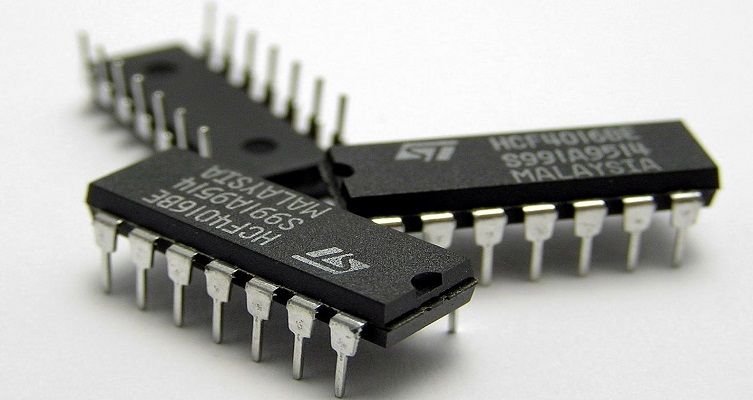
These are the little black squares that come up in your mind when people say "Hardware". Inside every single one of those little black squares are millions of transistors intricately laid up doing really smart things. Integrated circuits come in all shapes, sizes and they functionally do really different things. It could be a little timer; it could be just plain old memory or it could be a fully-fledged processor.
Inside these little black box, all the transistors are laid out and electricity is flowing through metal in different ways to do really cool things. Smart hardware engineers design these things and combining various integrated circuits together lets you do even cooler things. Alright, enough of that, we're leveling up.
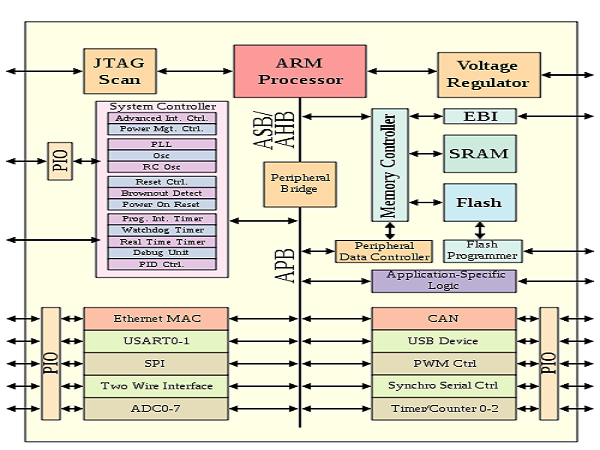
This is an SOC or System-On-Chip -Wikipedia
SOC is a really fancy name but it’s just a beefed-up integrated circuit. The picture above is just a diagram of a really common SOC. Looking at the real thing wouldn't really make any sense, do you want to look at 1 million transistors and make sense of it? Don't look at the individual parts yet, just take it in and I’m gonna expound on it.
What exactly is an SOC?
It's actually pretty simple, an SOC is just a combination of various different components that might have existed on different integrated circuits, all inside the same chip. They're pretty complicated but they're kind of just like the integrative circuits “Big Brother”.
Inside each SOC, there are a ton of things. There could be multi-core application processors, multi-core graphics processors, different cache memories and there could be digital signal processors all in the same chip. Everything comes together and it makes a system or SOC System-On-Chip. For the rest of the article, I'm going to use the word “SOC” a lot.
Every single smartphone that you might be using has multiple SOCs. Just look back at the picture above and take it in. It's a really general picture, what you see there are potentially different components that might exist inside a SOC. In the middle at the top, you see the main ARM processor. Remember “ARM” as an instruction set, so when I mention ARM processor, this is just a very general ARM processor that's implementing that instruction set.
Take a look on the right side of the chip, you see a lot of special hardware that interfaces with memory. You can't really fit two gigs of memory inside that chip, that's why they have special hardware components or memory controllers which talk with external memory. They're way too many things to cover inside this one SOC but it's almost like a mini computer and is the size of your thumb.
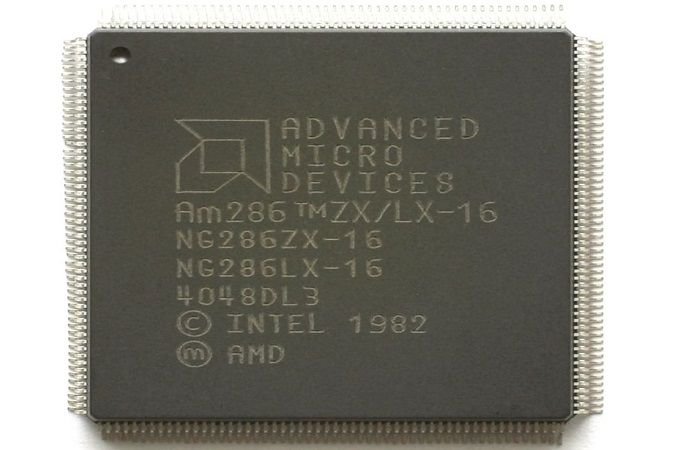
From the outside, it's also just a little black Square and it's just a little bigger. -Wikipedia
This is what an SOC looks like in real life. The bigger the black square and more transistors.
[4] Logic board 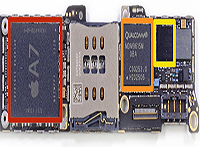
The picture by your right is a logic board. I'm going to be picking the old iPhone 5s in this article because it was a really groundbreaking phone in terms of hardware and this is actually the logic board that you'll find inside the 5s. It is literally the hardware backbone of the 5s, the first thing I want you to check out is that Big Red Square.
The Red Square is Apple's SOC called the “A7” and it was a legendary System-On-Chip. The SOC contains a lot of cool stuff, like dual core processors to run your iOS and also quad core GPUs to run all your games.
The SOC is a full system, so why exactly was the A7 a big deal?
The A7 was pretty groundbreaking because it was the first SOC to contain an application processor that was 64-bit. It was the first mobile applications processors that implement a 64-bit instruction set. Specifically, the application processor inside the A7 implements in a structure set called “ARM V8” For a really long time, almost all mobile processors were implementing ARM v7 which was a 32-bit instruction set, so when Apple came out with this A7, it was just a really big step forward for hardware, Apple and the whole mobile Industry.
If you're a little fuzzy on what ARM is, ARM is a British company which is best known for defining the “ARM” instruction set. You can google that later to get more info.
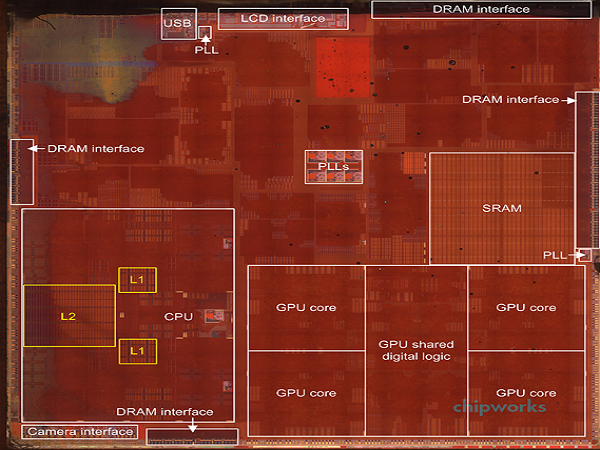
Let's zoom in a little bit. This is the floor plan of the A7, this is what it actually looks like.
You can see that there are a lot of people in the world that dissect these chips to really figure out what's going on. As you can see in the picture above, whoever created it, they dissected the A7 and they figured out the location of the GPUs, cache memory and how many processors there are. Actually, only Apple would really know where everything is inside this thing. The A7 is rendering iOS and all those GPUs inside, letting you play all those games.
[6] Logic board 
Let's zoom out again and go back to the logic board. We're outside the A7 now, you notice that the picture by your right has other boxes there, the A7 isn't the only SOC inside the 5s. Check out the orange box real quick, that's actually a Qualcomm modem that's given the 5s it's LTE.
There are a lot of different parts inside the 5s not coming from Apple. That orange square is a Qualcomm modem and Apple bought that from Qualcomm to stick it inside their phones to give you really fast internet. The modem is what gives you the signal bars, we're not going to zoom into the modem because it's really complicated, trust me, it’ll just make us cry.
There are only a few things boxed here but let me assure you that on this logic board, there are a ton of different SOC and different integrated circuits. It's impossible to go through all of them. Another SOC that I want to mention is called the “M7”. The “M” in M7 stands for “Motion”, it's another full SOC and it lives on the logic board inside the iPhone. I actually don't think it's the yellow square, I think it's actually somewhere else but yellow square is some other thing.
The M7 has compasses, gyroscopes, accelerometers and tons of sensor stuffs. It gathers a lot of data from you and it's that thing that powers a lot of the fitness applications on your iPhone.
In Conclusion
We started with integrated circuits which are very simple, circuits doing particular things coming in all shapes and sizes. if you combine a lot of components together, you get a SOC or System-On-Chip. Many smartphones have multiple SOCs. Apple’s signature SOC for the 5s was the A7 and it's already old news. All the different SOC like the A7 and M7, live on a logic board that's right inside your phone.
Remember, beside the SOC and the modems on the logic board, there’s a ton of stuff happening that I didn't cover. You have a lot of other stuff going on inside the phone like a screen, the touch sensor, camera lens but this isn't the real hardware. Those are kind of like the peripherals and it's not the real hardware.
The logic board that we just reviewed, where all the SOCs are sitting on, that's the real hardware. You can see how a lot of different companies contribute their products to make smartphones function. Apple does a lot of it but not all.
If you're a software engineer, always respect hardware engineers or else your software would run on nothing. If you're a hardware engineer, respect software engineers because without that software running on it, the phone would be literally less useful than a brick.
Hardware and software, each have a lot of different levels within them. There are so many different levels and parts of an engineering stack and they all need each other. If you enjoyed this article, don’t hesitate to smash that upvote button below.
References: 1 - 2 - 3 - 4
Image sources: 1 - 2 - 3 - 4 - 5 - 6


GIF made by @foundation

I really enjoyed the post. Hardware and software engineers own each other respect as none can function without the other.
Thanks man.
Your writing style is great, I like the level of detail you used and the use of graphics, well done. Are you familiar with Arduino? I would enjoy a read at this level of detail about Arduino or its counterparts if there are any. Particularly the floorplan view of the A7, that representation made me appreciate all that is in this SOC. In any case, I enjoy whatever topic you choose to share, keep them coming.
I'm not familiar with Arduino but I'd love to read and write about it someday.
Thanks for the compliments man, I'll definitely keep them coming. Thanks for keeping in touch.
nice writeup... I really enjoyed it
Thank you, I'm glad you did.